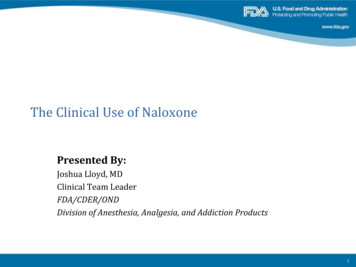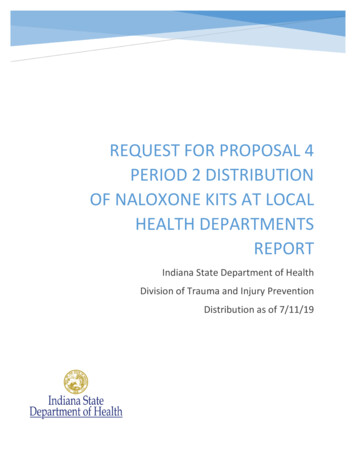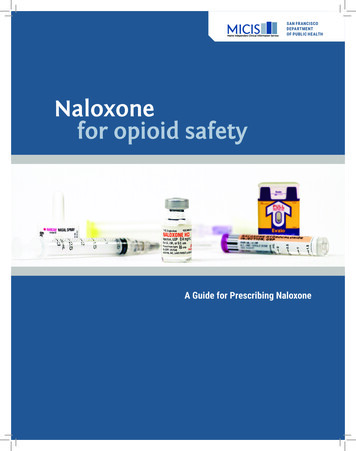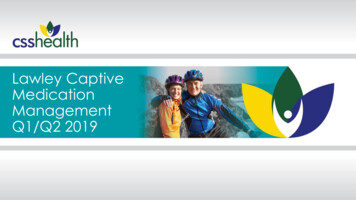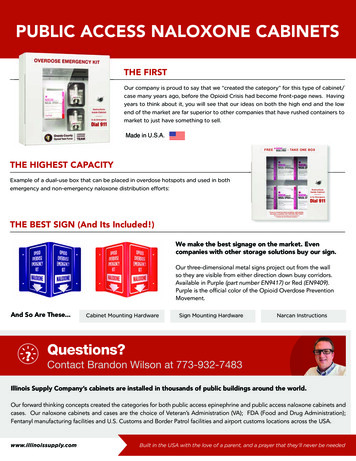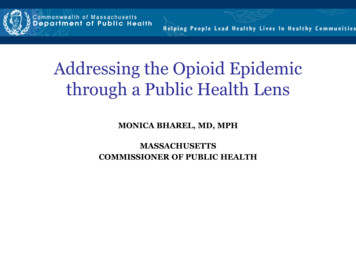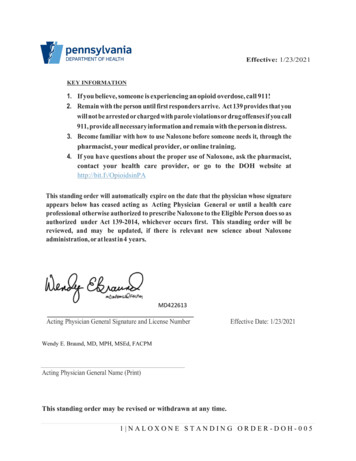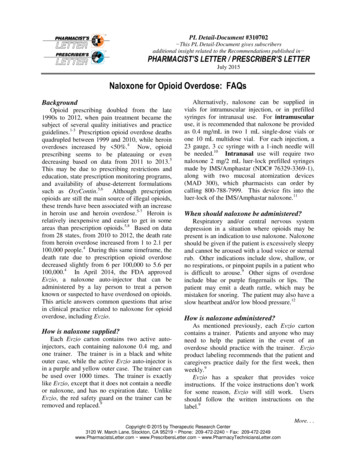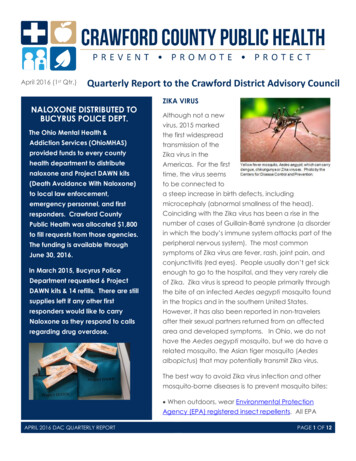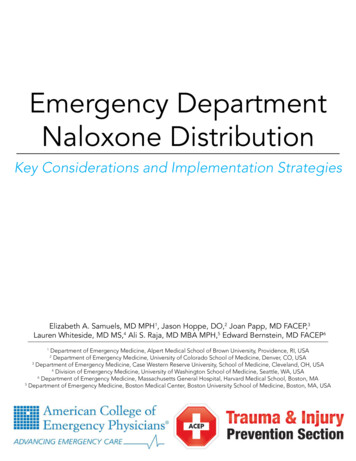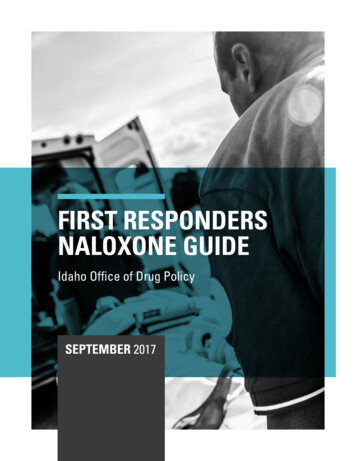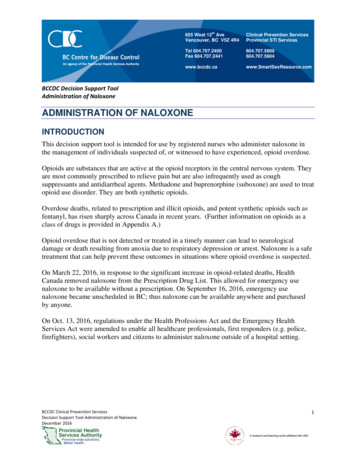
Transcription
th655 West 12 AveVancouver, BC V5Z 4R4Clinical Prevention ServicesProvincial STI ServicesTel 604.707.2400Fax w.SmartSexResource.comBCCDC Decision Support ToolAdministration of NaloxoneADMINISTRATION OF NALOXONEINTRODUCTIONThis decision support tool is intended for use by registered nurses who administer naloxone inthe management of individuals suspected of, or witnessed to have experienced, opioid overdose.Opioids are substances that are active at the opioid receptors in the central nervous system. Theyare most commonly prescribed to relieve pain but are also infrequently used as coughsuppressants and antidiarrheal agents. Methadone and buprenorphine (suboxone) are used to treatopioid use disorder. They are both synthetic opioids.Overdose deaths, related to prescription and illicit opioids, and potent synthetic opioids such asfentanyl, has risen sharply across Canada in recent years. (Further information on opioids as aclass of drugs is provided in Appendix A.)Opioid overdose that is not detected or treated in a timely manner can lead to neurologicaldamage or death resulting from anoxia due to respiratory depression or arrest. Naloxone is a safetreatment that can help prevent these outcomes in situations where opioid overdose is suspected.On March 22, 2016, in response to the significant increase in opioid-related deaths, HealthCanada removed naloxone from the Prescription Drug List. This allowed for emergency usenaloxone to be available without a prescription. On September 16, 2016, emergency usenaloxone became unscheduled in BC; thus naloxone can be available anywhere and purchasedby anyone.On Oct. 13, 2016, regulations under the Health Professions Act and the Emergency HealthServices Act were amended to enable all healthcare professionals, first responders (e.g. police,firefighters), social workers and citizens to administer naloxone outside of a hospital setting.BCCDC Clinical Prevention ServicesDecision Support Tool‐Administration of NaloxoneDecember 20161
th655 West 12 AveVancouver, BC V5Z 4R4Clinical Prevention ServicesProvincial STI ServicesTel 604.707.2400Fax w.SmartSexResource.comBCCDC Decision Support ToolAdministration of NaloxoneCONSIDERATIONS FOR WORKING WITH PEOPLE WHO USESUBSTANCESNurses and other health care providers play a vital role in the care of people who use substances.First and foremost - language matters. Language should be used to describe or refer to the personfirst; for example, a ‘person with a substance use disorder’, as opposed to ‘a drug abuser’ or‘addict’. Adopting accurate, clinical, and non-judgemental language when communicating aboutaddiction will serve to positively influence perceptions and reduce assumptions made aboutaddiction, those it affects, and its therapy.Stigma often drives people to isolation and alienation; distancing themselves from theircommunities and families, and building reluctance in accessing healthcare services or treatment.Interactions and conversations should begin with compassion, care, and engagement. Utilize atrauma-informed approach recognizing that individuals have different lived-experiences thatshape their behaviours, sense of self and well-being, sense of safety, and engagement withothers.Actively involve and invite individuals to participate in their own care. Incorporate anenvironment of safety, trust and acceptance (focus on the person rather than the behaviour).These simple approaches, when used alongside harm reduction strategies, the provision of harmreduction information and supplies, and evidence-based interventions, can assist in yielding thebest opportunities for helping individuals access and get the care and treatment they need toachieve the highest level of health possible.BCCDC Clinical Prevention ServicesDecision Support Tool‐Administration of NaloxoneDecember 20162
th655 West 12 AveVancouver, BC V5Z 4R4Clinical Prevention ServicesProvincial STI ServicesTel 604.707.2400Fax w.SmartSexResource.comBCCDC Decision Support ToolAdministration of NaloxoneCLINICAL FEATURES OF OPIOID OVERDOSESigns and symptoms of opioid intoxication include: Absence of respirations (apnea) or decreased respiratory rate – a respiratory rate of 10-12/min is the best clinical predictor of opioid intoxicationGurgling or snoring type soundsAltered mental status to loss of consciousness (minimally responsive to unresponsive)(see Appendix B)Constricted/pinpoint pupils – the presence of pinpoint pupils alone is not sufficient toinfer opioid intoxicationSlow, erratic or absent heart rateVomitingCold and clammy skin (may appear cyanotic (blueish) especially around the lips /nailbeds in individuals with lighter skin; individuals with darker skin may be grayishor ashen)Ongoing assessment of opioid intoxication should largely be based on respiratory rate andmental status/level of consciousness.ASSESSMENTSubjective and objective assessments should be rapidly performed to determine if opioidoverdose is suspected and whether naloxone administration is indicated. The assessment shouldalso look for factors that might complicate the management of overdose and thus trigger morerapid referral to a hospital setting. When available, subjective information from individuals,family and friends should be taken, however, objective findings should guide clinical decisionmaking.BCCDC Clinical Prevention ServicesDecision Support Tool‐Administration of NaloxoneDecember 20163
th655 West 12 AveVancouver, BC V5Z 4R4Clinical Prevention ServicesProvincial STI ServicesTel 604.707.2400Fax w.SmartSexResource.comBCCDC Decision Support ToolAdministration of NaloxoneSubjective AssessmentObjective AssessmentHistory of opioid use from individual,family or friendsInformation about specific drug use,amount used, route of administrationand time of useVital Signs Absence of respirations (apnea) ordecreased respiratory rate – arespiratory rate of 10‐12/min is thebest clinical predictor of opioidintoxication Slow, erratic or absent heart rate Oxygen saturation of 90% on roomairVisible signs of head trauma*Past Medical History* Any recent severe infections DiabetesOther Signs of Opioid Intoxication Cardiovascular or respiratory disease Gurgling or snoring type sounds Altered mental status to loss ofconsciousness (minimally responsive tounresponsive)Head injury or trauma*Seizure disorders*Medications* including methadone,lithium, phenytoin, and insulin Constricted/pinpoint pupils Vomiting Cold and clammy skin (may appearcyanotic (blueish) especially around the lips /‐ nailbeds in individuals with lighter skin;individuals with darker skin may be grayishor ashen)Concomitant use of other drugs oralchohol**THESE COMPLICATE MANAGEMENT AND TRIGGER MORE RAPID REFERRAL TO HOSPITAL.BCCDC Clinical Prevention ServicesDecision Support Tool‐Administration of NaloxoneDecember 20164
th655 West 12 AveVancouver, BC V5Z 4R4Clinical Prevention ServicesProvincial STI ServicesTel 604.707.2400Fax w.SmartSexResource.comBCCDC Decision Support ToolAdministration of NaloxoneOTHER CAUSES OF ALTERED MENTAL STATUS/LOSS OFCONSCIOUSNESSThe diagnosis of opioid overdose includes toxic and nontoxic conditions that can alter mentalstatus and/or respiratory rate.Substances which can alter mental status and/or respiratory rate and thus confound the diagnosisof opioid overdose include but are not limited to: Alcohol Gamma Hydroxybutyrate (GHB) Marijuana Sedative-hypnotics (eg. barbiturates, benzodiazepines) Clonidine Hypoglycemic medications Carbon monoxideMedical conditions producing an altered mental status or loss of consciousness may be mistakenfor opioid overdose or can be concomitant. Other conditions that should be considered broadlyduring assessment are: Acute neurological presentations of opportunistic infections Sepsis Metabolic causes such as hypoglycaemia and electrolyte disturbances, and Structural causes such as head trauma and intracranial hemorrhage.Several bodies of evidence suggest there is no maximum dose of naloxone that can beadministered; however, other causes of altered mental status/loss of consciousness should beconsidered if there is no clinical response following administration of multiple doses ofnaloxone. Clinical judgment needs to be weighed against the number of doses of naloxonegiven, time elapsed since administration of first dose (e.g. if 5-6 doses of naloxone are given,this should equate to a time lapse of approximately 20-30 minutes), client responsiveness(most importantly presence or absence of pulse and/or respirations) and presenting scenario.Regardless, it remains important to stay with the individual until EMS arrives. Continuerescue breathing /- CPR until the individual is able to breathe on their own.BCCDC Clinical Prevention ServicesDecision Support Tool‐Administration of NaloxoneDecember 20165
th655 West 12 AveVancouver, BC V5Z 4R4Clinical Prevention ServicesProvincial STI ServicesTel 604.707.2400Fax w.SmartSexResource.comBCCDC Decision Support ToolAdministration of NaloxoneINFORMATION ON NALOXONE HCLClassificationPure opioid antagonistMechanismTemporarily reverses the effects of opioids by competing for the same receptor sites.Naloxone has no pharmacological affect if administered in the absence of opioids.IndicationsAdministered for complete or partial reversal of opioid depression.ContraindicationsHypersensitivity to naloxone or to any ingredient in the formulation or component ofthe containerDoseInitial dose*: 0.4mg IMIf insufficient response to initial dose, subsequent dosing should be administeredaccording to the following schedule:Subsequent dose: 0.4 mg, 0.4 mgEach dose should be administered 3-5 minutes apartNaloxone can be given until EMS arrives or individual is able to breathe on their own.Clinical judgment to discontinue naloxone administration needs to be weighedagainst the number of doses of naloxone given, time elapsed since administration offirst dose, client responsiveness and presenting scenario.Route ofAdministrationIV, IM, SCIntramuscular (IM) is the preferred route of administration in the communitysettingOnsetIV Less than 2 minIM/SC 3-5 minutesDuration of Action20 to 90 minutesEliminationMetabolized in the liver; excreted in urineBCCDC Clinical Prevention ServicesDecision Support Tool‐Administration of NaloxoneDecember 20166
th655 West 12 AveVancouver, BC V5Z 4R4Clinical Prevention ServicesProvincial STI ServicesTel 604.707.2400Fax w.SmartSexResource.comBCCDC Decision Support ToolAdministration of NaloxoneSide EffectsAbrupt reversal of opioid depression may result ythmiasEmotional gTremulousnessOtherPain/pain crisis(if opioid used for pain management)An initial dose of 0.2 mg IM/SC of naloxone may be administered in select clinicalenvironments such as supervised consumption sites or mobile medical units - whereextra supports (e.g. pulse oximetry and/or supplemental oxygen, bag-valve-masks)are available and capacity exists for continued resuscitation and monitoring.Similarly, in these select clinical environments (advanced practice settings), 911 maynot necessarily be activated if adequate staffing and training support the capacity tocontinually monitor individuals and resuscitate and provide care as needed.Refer to your site specific organizational guidelines or policies.Naloxone is not effective in counteracting depression due to barbiturates,tranquilizers, psychostimulants (e.g. cocaine), alcohol or other non-opioid anestheticsor sedatives.Can cause abrupt state of opioid withdrawal in the physically dependent individual.Side effects such as agitation and aggressiveness can be symptoms of opioidwithdrawal and may be exacerbated by an individual regaining consciousness in apotentially unfamiliar environment.Naloxone’s duration of action (20 to 90 minutes) is shorter than that of all opioids;therefore, individuals should be observed until the opioid effect has worn off. Specialattention should be given to individuals that may have ingested long acting opioidssuch as methadone.StorageStore between 15⁰C-30⁰C. Keep away from light.BCCDC Clinical Prevention ServicesDecision Support Tool‐Administration of NaloxoneDecember 20167
th655 West 12 AveVancouver, BC V5Z 4R4Clinical Prevention ServicesProvincial STI ServicesTel 604.707.2400Fax w.SmartSexResource.comBCCDC Decision Support ToolAdministration of NaloxoneMANAGEMENTBegin management if opioid overdose is suspected following assessment and there are nocontraindications. Naloxone is used alongside the principles of basic life support (BLS) /cardiopulmonary resuscitation (CPR; compressions plus ventilation) in the management ofsuspected or witnessed opioid overdose.Responders should not delay access to more advanced medical services while awaiting theindividual’s response to naloxone or other interventions. Unless the individual refuses care,individuals who respond to naloxone administration should access advanced healthcareservices.The goal of naloxone administration is to: Achieve adequate spontaneous ventilation (RR 10/min)Protect the airwayNot precipitate acute withdrawal symptomsThe following flow diagram is intended to assist in the management of witnessed or suspectopioid overdose.BCCDC Clinical Prevention ServicesDecision Support Tool‐Administration of NaloxoneDecember 20168
MANAGEMENT OF WITNESSED OR SUSPECT OPIOID OVERDOSE9
th655 West 12 AveVancouver, BC V5Z 4R4Clinical Prevention ServicesProvincial STI ServicesTel 604.707.2400Fax w.SmartSexResource.comBCCDC Decision Support ToolAdministration of NaloxoneCLINICAL FEATURES OF ACUTE OPIOID WITHDRAWALFollowing naloxone administration, acute opioid withdrawal may occur in individuals who arechronic opioid users.Signs and symptoms of opioid withdrawal include but are not limited to: Anxiety, irritability, aggressive behaviour Dilated (mydriatic) pupils Sweating, chills, goosebumps (cutis anserine) Nausea and vomiting Diarrhea Abdominal cramps Tachycardia (increased heart rate) Tremulousness Muscle and joint painFOLLOW-UP CAREThe effects of naloxone wear off after 20-90 minutes while the effect of most opioids last muchlonger. It is recommended that persons who receive naloxone be monitored until EMS arrives(see ‘special considerations’ for advanced practice settings – page 7).If individuals refuse follow-up care, encourage them to stay with someone who can assist them orcall for help if needed and/or remain in a public space. Advise them not to use further opioids fora minimum of 2-3 hours following the last dose of naloxone.It is recommended that individuals be monitored for a minimum of 2-3 hours following the lastdose of naloxone to ensure they do not experience opioid effects following wear-off of naloxone.Give naloxone again as needed.If the individual has ingested opioids, or are on methadone and buprenorphine, and have requiredmore than 2 doses of naloxone ( 0.9 mg) to regain responsiveness, they remain at higher risk forprolonged opioid effects and will need to be monitored for a longer period of time. Advise to go tonearest emergency department or inpatient assessment.BCCDC Clinical Prevention ServicesDecision Support Tool‐Administration of NaloxoneDecember 201610
th655 West 12 AveVancouver, BC V5Z 4R4Clinical Prevention ServicesProvincial STI ServicesTel 604.707.2400Fax w.SmartSexResource.comBCCDC Decision Support ToolAdministration of NaloxoneCLIENT EDUCATION Explain the events leading to the decision to administer naloxoneExplain the effects of naloxone wear off after 20-90 minutes while most opioids last muchlonger. This is why it is important to stay with the individual until help arrives or for atleast 2 hoursIf individual is opioid dependent, let them know that when the naloxone wears off,withdrawal symptoms will subsideExplain the importance of not taking more opioids following naloxone administrationbecause overdose can return and/or the opioids themselves may not work in the presenceof naloxone (i.e. the individual will not get “high”)Explain the importance of going to the hospital for follow-up care and monitoring –overdose may return, they may have inadvertently hit their head when they overdosed,they may have aspirated on vomit (risk for pneumonia)Offer new or replacement THN kitGive specific harm reduction information as needed:o Know one’s health status and tolerance People who have had an overdose are at an increased risk for an overdosehappening again After a period of abstinence tolerance is reduced consider using less changing route of administration (e.g. switch from IV use to oral/nasaladministration)o Do not mix drugs and alcohol Educate about the additive effects of medications or alcoholo Do not use alone if possible Leave your door unlocked Tell someone to check on youo Do ‘testers’ - a small amount of a substance (smaller than which is “normally”consumed) to check for potency Try a small portion first Use less Pace yourselfo Ask if they would consider incorporating family or friends into safety plan andeducating those identified about overdoseBCCDC Clinical Prevention ServicesDecision Support Tool‐Administration of NaloxoneDecember 201611
th655 West 12 AveVancouver, BC V5Z 4R4Clinical Prevention ServicesProvincial STI ServicesTel 604.707.2400Fax w.SmartSexResource.comBCCDC Decision Support ToolAdministration of NaloxoneDOCUMENTATIONDocument according to your organization’s policies.BCCDC Clinical Prevention ServicesDecision Support Tool‐Administration of NaloxoneDecember 201612
th655 West 12 AveVancouver, BC V5Z 4R4Clinical Prevention ServicesProvincial STI ServicesTel 604.707.2400Fax w.SmartSexResource.comBCCDC Decision Support ToolAdministration of NaloxoneREFERENCESAlveda Pharmaceuticals. (2014). Naloxone hydrochloride Injection USP. Retrieved fromhttp://www.alvedapharma.com/PDF/PI4WS/ALV Naloxone verdoseArthur, E., Seymour, A., Dartnall, M., Beltgens, P., Poole, N., Smylie, D., North, N., & Schmidt,R. (2013). Trauma-informed practice guide. Retrieved from http://bccewh.bc.ca/wpcontent/uploads/2012/05/2013 TIP-Guide.pdfBC Laws. (2016). Province of British Columbia Ministry of Health: Regulation of the minister ofhealth: Emergency health services act. Retrieved 016 m397Botticelli, M.P., & Koh, H.K. (2016). Changing the language of addiction. Journal of theAmerican Medical Association, 316(13). 1361-1362.Boyer, E. W. (2012). Management of opioid analgesic overdose. The New England Journal ofMedicine, 367(2). DOI: 10.1056/NEJMra1202561Broyles, L. M., Binswanger, I. A., Jenkins, J. A.,Finnell, D. S., Faseru, B., Cavaiola, A., Pugatch,M., & Gordon, A. J. (2014). Confronting Inadvertent Stigma and Pejorative Language inAddiction Scholarship: A Recognition and Response. Substance Abuse, 35(3), 217-221.Canadian Red Cross. (2016). Canadian consensus guidelines on first aid and CPR. Retrieved Consensus-Guidelines-document-Feb2016 EN Final.pdfCadario, B.J. & Leathem, A. M. (2003). Drug information reference: Naloxone. The BC Drug andPoison Information Centre.College of Pharmacists of British Columbia. (2016). Non-prescription naloxone now availableoutside of pharmacies. Retrieved from: naloxone-now-available-outside-pharmaciesBCCDC Clinical Prevention ServicesDecision Support Tool‐Administration of NaloxoneDecember 201613
th655 West 12 AveVancouver, BC V5Z 4R4Clinical Prevention ServicesProvincial STI ServicesTel 604.707.2400Fax w.SmartSexResource.comBCCDC Decision Support ToolAdministration of NaloxoneErickson, T.B. , Thompson, T.M., & Lu, J.J. (2207). The approach to the patient with an unknownoverdose. Emergency Medicine Clinics of North America, 25(2), 249-281.Goodwin, J., Kestler, A., DeWitte, C. & Pursell, R. (2016). The UBC department of emergencymedicine: Opioid overdose best practices guideline. [in draft]Harm Reduction Coalition. (n.d.). Recognizing opioid overdose. Retrieved verdose/Kim, H. K. & Nelson, L. S. (2015). Reducing the harm of opioid overdose with the safe use ofnaloxone: A pharmacologic review. Expert Opinion on Drug Safety, 14(7), 1137-1146.doi: 10.1517/14740338.2015.1037274Levy, J. (2014). Stigmatising people who use drugs. International Network of People who UseDrugs. Retrieved tributions/Civil/INPUD/DUPIStigmatising People who Use Drugs-Web.pdfSandoz Canada. (2016). Product monograph including patient medication information: S.O.Snaloxone hydrochloride injection. Retrieved fromhttp://www.sandoz.ca/cs/groups/public/@sge ca/documents/document/n prod 1739152.pdfTeasdale, G., Allen, D., Brennan, P., McElhinney, E., & Mackinnon, L. (2014). The GlasgowComa Scale: an update after 40 years. Nursing Times, 110, 12-16.The American Heart Association. (2015). Guidelines for cardiopulmonary resuscitation andemergency cardiovascular care: Part 10: Special circumstances of resuscitation. Retrievedfrom ircumstances-of-resuscitation.pdfThe BC Drug and Poison Information Centre. (2015). Poison Management Manual: Naloxone –antidote.BCCDC Clinical Prevention ServicesDecision Support Tool‐Administration of NaloxoneDecember 201614
th655 West 12 AveVancouver, BC V5Z 4R4Clinical Prevention ServicesProvincial STI ServicesTel 604.707.2400Fax w.SmartSexResource.comBCCDC Decision Support ToolAdministration of NaloxoneTowards the Heart. (2012). Overdose survival guide: Tips to save a life. Retrieved /OD Survival Guide Tips to Save a Life 2012.08.29 upright for website.pdfTowards the Heart. (2012). SAVE ME step-by-step training poster. Retrieved n-the-trainer 227.pdfWolfe, S., Bouffard D. L., & Modesto-Lowe, E. V. (2016). The opioid crisis and the physicians’srole in contributing to its resolution: Step one – prevention of overdoses. ConnecticutMedicine, 80(6), 325-334.BCCDC Clinical Prevention ServicesDecision Support Tool‐Administration of NaloxoneDecember 201615
th655 West 12 AveVancouver, BC V5Z 4R4Clinical Prevention ServicesProvincial STI ServicesTel 604.707.2400Fax w.SmartSexResource.comBCCDC Decision Support ToolAdministration of NaloxoneAPPENDIX A. BASIC INFORMATION ON OPIOIDSOpioids are substances that are active at the opioid receptors in the central nervous system (CNS).The term opioid refers to natural and synthetic substances with morphine-like activity.Opioids have analgesic and CNS depressant effects, as well as the potential to cause euphoria.Opioid dependence or addiction is defined as continued use of opioids despite significant opioidinduced problems; these problems may be cognitive, behavioral, or physiological. Repeated druguse results in opioid tolerance, withdrawal symptoms, and compulsive drug taking.Commonly used opioids: Codeine Heroin Morphine Meperidine Methadone Hydromorphone Fentanyl Opium Pentazocine OxycodoneBCCDC Clinical Prevention ServicesDecision Support Tool‐Administration of NaloxoneDecember 201616
th655 West 12 AveVancouver, BC V5Z 4R4Clinical Prevention ServicesProvincial STI ServicesTel 604.707.2400Fax w.SmartSexResource.comBCCDC Decision Support ToolAdministration of NaloxoneAPPENDIX B. RESPONSE INDEX*Responsive – Individual is alert and awake and able to maintain spontaneous eye opening, verbalresponse and coordinated motor functionsMinimally Responsive – Individual is able to respond when spoken to (clear or incomprehensiblespeech or sounds), and responsive when pain stimulus applied (eye opening, localized flexion,withdrawal, extension)Non-Responsive – Individual has no response to voice or pain.*Adapted from the Glasgow Coma ScaleBCCDC Clinical Prevention ServicesDecision Support Tool‐Administration of NaloxoneDecember 201617
BCCDC Decision Support Tool Administration of Naloxone BCCDC Clinical Prevention Services Decision Support Tool‐Administration of Naloxone December 2016 1 655 West 12th Ave Vancouver, BC V5Z 4R4 Tel 604.707.2400 Fax 604.707.2441 www.bccdc.ca Clinical Prevention Services Provincial STI Services 604.707.5600 604.707.5604
